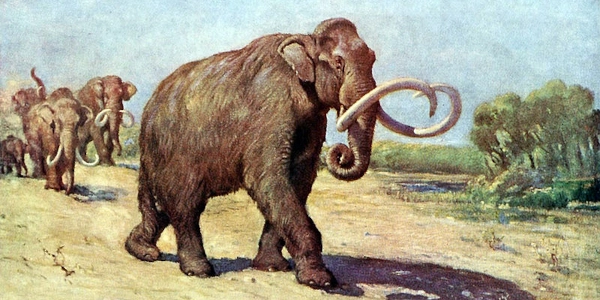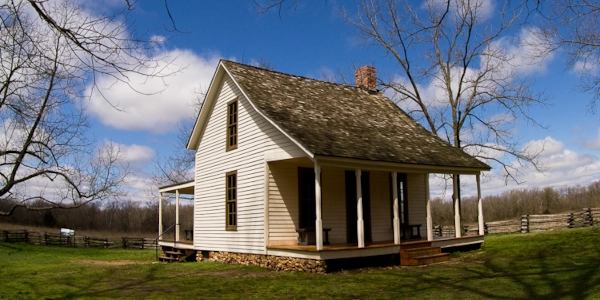
Image above: Lithograph of U.S. Grant after his command at small battle like Belmont and eventual victory at Appomattox, 1868, Charles H. Crosby. Courtesy Library of Congress.
Spotlight on Lesser Known History
Battle of Belmont, Missouri
America's Best History Spotlight
On this page we're going to Spotlight the lesser known historic sites and attractions that dot the history landscape across the USA and are worth a visit if you're in their area. And while they may be lesser known, some are very unique, and will be that rare find. You'll be, at times, on the ground floor, or maybe even know something others don't. It'll be fun. Visit them.
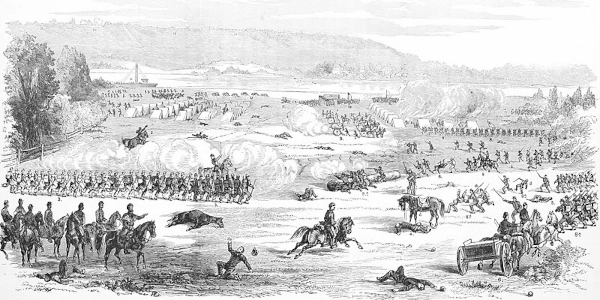
Battle of Belmont, Missouri
U.S. Grant had been a soldier during the Mexican War, an itinerant farmer, and somehow had gotten to know Abraham Lincoln during his days as a traveling judge. Therefore, when Grant rejoined the Army during the first year of the Civil War, he had little command experience. However, by August 28, 1861, he had been put in command of southeastern Missouri. A series of events soon unfolded. Neutral Kentucky was invaded by General Leonidas Polk by taking the town of Columbus, Kentucky, directly across the Mississippi River from Belmont, Missouri. After considering an attack by river, Grant decided he could not best the formidable positions of the Confederates. However, some Confederates decided to test him at Belmont, crossing the river to string a chain to stop any Union gunboats from traveling south. Image above: Drawing of the Battle of Belmont, 1894, Frank Leslie's Illustrated. Courtesy Library of Congress.
Sponsor this page. Your banner or text ad can fill the space above.
Click here to Sponsor the page and how to reserve your ad.
Info, What's There Now, History Nearby

Battle of Belmont, Missouri
General Fremont did not want Grant to attack; he preferred containment of the Confederates from moving further west, and told Grant to deploy from Cairo, Illinois on November 6, 1861 with the mission of containment. However, Grant heard that the Confederates attempt was to attack Missouri citizens who backed the Federal Army, so he headed straight for Belmont instead.
Today, you can visit a very small section of the battleground, in a state park on the Kentucky side where Confederates had built defenses, but it's still worth a visit to learn about the strategy that Grant would employ and how this led to larger things for the General.
The Kentucky fortifications at Columbus were completed in September 1861 by Confederate General Leonidas Polk as Fort DeRussy with 143 cannons. The park commemorates the significance of this point in controlling the river, with Polk's giant chain, one mile long, at the position of Columbus and Belmont. Belmont, Missouri, no longer exists, overwhelmed by the river. Columbus is not much larger, with a population below two hundred and dwindling, and has been subject to flooding over the decades. The state park sits on a bluff two hundred feet above the river with much of the Confederate buildings and earthworks taken by the Mississippi, too, although some of the earthworks remain.
Image above: A map of the Battle of Belmont, 1895, Charles H. Arms, U.S. War Department. Courtesy Wikipedia Commons. Below: Montage of two Confederate Generals involved in the Battle of Belmont; Lt. General Leonidas Polk (left), circa 1863-4, T. Lilienthal; and Brigadier General Gideon J. Pillow, 1870 author unknown. Polk courtesy Alabama Digital Archives via Wikipedia Commons; Pillow courtesy Wikipedia Commons.

Where Is It
Waco Mammoth National Monument is located at 6220 Steinbeck Bend Drive, Waco, TX 76708. Waco itself is located in the north-central section of the state, one hundred and eight-five miles northwest of Houston, and just under one hundred miles south of the Dallas/Ft. Worth area.
What is There Now
Columbus Belmont State Park
In 1925 after the river receded, a good portion of Polk's chain was recovered. It is the main attraction of the park. The park was dedicated by the state in 1934. The anchor weighs four to six tons. The Civilian Conservation Corps built a monument to hold it and the remaining chain. Also in the park is a huge cannon dedicated to Polk's wife. "Polk's Wife" weighed 15,000 pounds and was ten feet long. It bombarded Union troops at the Battle of Belmont until its last fired shot exploded the cannon itself and killed eighteen Confederate soldiers.
Today a museum in a farmhouse that had been a Confederate hospital serves as its visitor center. There is a campground overlooking the Mississippi River, miniature golf, hiking trails along the Confederate earthworks, a snack bar and mini-golf on the one hundred and fifty-six acre parkland.
When Open and How Much
The Columbus-Belmont State Park is open daily May to Septeber, and on weekend in April and October. Admission costs $4.00 for adults and $3.00 for children and seniors. Unsure of the extra charges for the mini-golf and camping (likely) or other activities.
Fees subject to change.
Websites
Columbus-Belmont State Park
History Nearby
This area long the Mississippi River between Missouri and Kentucky holds a variety of attractions, but non real close to Belmont, which does not exist, or Columbus, which is holding on. Wickliffe Mounds State Historic Site is not too far north of Columbus, there's more Civil War sites such as Perryville, Wilson's Creek, and more as well.
-
Perryville
-
St. Louis Gateway
-
Wilson's Creek
-
George Washington
Carver NM -
Ozark National
Scenice River -
Shiloh NMP
Buy Chronology

Great Book for the History Fan with Fifty Short Essays Telling the Story of American History.
Photos, History, and More Spotlights

The Battle
Grant debarked his troops three miles northwest of the Confederate camps at Belmont on November 7, 1861. They surprised Pillow's troops, driving them back to their camp, which backed to the Mississippi River. Thinking they had victory, the Union troops began to loot the camp. However, General Polk had no desire to stop the fight, firing his cannons from across the river and sending reinforcements to urge Pillow's troops to counterattack.
When the Confederates landed north of Belmont along the same path as Grant's troops had gone, Grant quickly realized that his outnumbered troops must retreat and would find it difficult to get back to their ships with troops to his south and north. Grant jumped onto the transport ships last and headed to his cabin to rest.
"The captain of the boat that had just pushed out recognized me and ordered the engineer not to start the engine: he then had a plank run out for me. My horse seemed to take in the situation. He put his fore feet over the bank without hesitation or urging, and, with his hind feet well under him, slid down the bank and trotted on board," General Grant.
A firefight from shore hounded the ships as they made way toward Cairo; Grant went topside to sight it, only to return to his quarters to find his couch where he had been laying had been shot through.
Photo above: Union retreat by riverboat from the Battle of Belmont, 1887, Battles and Leaders of the Civil War. Courtesy Wikipedia Commons.
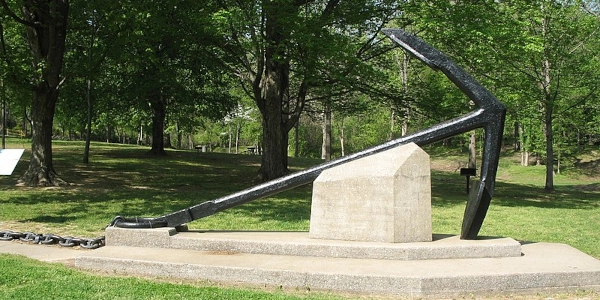
After the Battle
The Confederates saw the Battle of Belmont as victory, however, Grant viewed it differently, thinking that his fight had forced the enemy to abandon the detachment of troops from Columbus and that he had inflicted more casualties.
Although Grant had been forced to retreat and the retreat had almost been a disaster, President Lincoln started to gain a fondness for Grant's willingness to fight. It had also given Grant command experience. Even though Grant had less troops than his Confederate counterparts, 3,114 vs. nearly 5,000, they had inflicted almost the same amount of casualties; 641 Confederate, 601 Union. That tenacy to fight was a quality that had been lacking in Lincoln's generals during the first year of the war. Grant retreated back to his base in Paducah, Kentucky, where the troops from the Battle of Belmont formed the basis for the "Army of the Tennessee."
Photo above: The battlefield on the site of a Confederate fortification during the battle commemorated today with an iron anchor at Columbus-Belmont State Park in Kentucky, across the river from the main action of the battle in Missouri, 2007, Knowledgeum. Courtesy Wikipedia Commons.

T-Shirts and Gifts from the official souvenirs of Americasbesthistory.com.

U.S. Grant After Belmont
It would be a rather quick series of events and battles after Belmont that made Grant a household name and favorite of Lincoln. There would be Fort Henry and Fort Donelson, Shiloh, Vicksburg, all leading to his elevation in command to General of all Armies. Once in the Virginia theater, his tenacity to fight continued through the battles at the Wilderness, and Spotsylvania. During he final year of the war, Grant had pinned Lee down into a siege of Richmond and Petersburg, while Sherman marched on Atlanta to the sea. The surrender by General Robert E. Lee at Appomattox would finally culminate the Civil War in 1865.
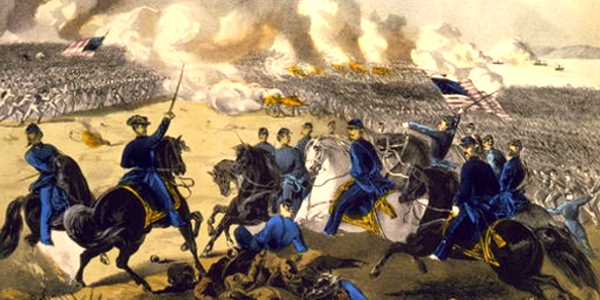
Photo above: Lithograph by Kurz and Allison of the Battle of Fort Donelson. Courtesy Library of Congress. Center: Currier and Ives 1862 print of General Grant leading a charge in the 2nd day of the Battle of Shiloh. Both images courtesy Library of Congress. Bottom: Clover Hill Tavern, Appomattox, Photo courtesy National Park Service.
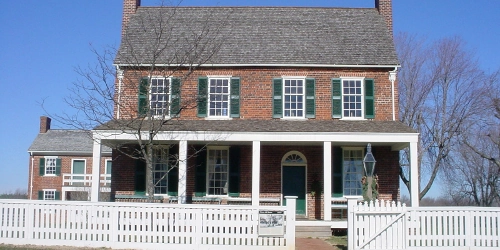
About
America's Best History where we take a look at the timeline of American History and the historic sites and national parks that hold that history within their lands.
Photos courtesy of the Library of Congress, National Archives, National Park Service, americasbesthistory.com and its licensors.
- Contact Us
- About
- © 2025 Americasbesthistory.com.
Template by w3layouts.
